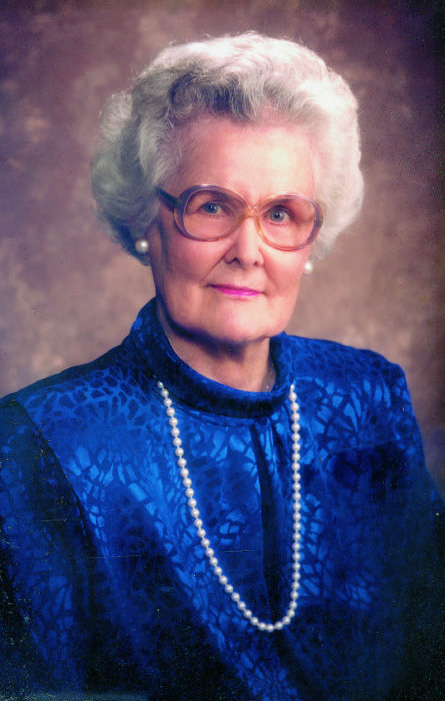BEBRF was founded in 1981 by Mattie Lou Koster and in the intervening 40 years funded almost three million dollars for research into blepharospasm worldwide. In addition, BEBRF provides patient support and patient/physician education. Learn more about BEBRF, its history, and activities here.

Dedication
Mattie Lou Koster (June 12, 1912 – October 25, 2001)
This website is dedicated to the memory of Mattie Lou Koster, without whom there would not be a Benign Essential Blepharospasm Research Foundation. The following tribute was written by Daniel Truong, M.D., taken from his book, “Living Well with Dystonia.”
”In 1986, I had a chance to share a bus ride to a dystonia retreat outside of New York City with a remarkable woman. I was a fellow in my first year in Movement Disorders, a new field of neurology. The motherly woman who spoke with a Texan drawl gently told me the story of a life with blepharospasm.
I do not remember now how long the bus ride was. For me, it went quickly as she was such a fascinating, inspiring woman. I learned so much about blepharospasm from her. She was an amazing woman with a disarming gentle charm.
After being diagnosed with blepharospasm in 1980, Mattie Lou Koster of Beaumont, Texas, decided to found the Benign Essential Blepharospasm Research Foundation (BEBRF) at the age of 68. In addition to suffering from the symptoms and associated difficulties of the disorder, she had recently lost her husband of 50 years. Koster was subsequently diagnosed with leukemia, breast cancer, and peripheral neuropathy. She later underwent a mastectomy and two hip replacements. Indeed, Koster was an amazingly courageous and resolute woman who overcame many obstacles to fulfill her mission of advancing knowledge about blepharospasm and providing support to people with the disorder. Koster was extremely dedicated to the BEBRF. She knew she was not the only person dealing with blepharospasm and wanted to help others with the disorder. With the knowledge that blepharospasm patients at the time felt isolated and struggled on a daily basis to deal with their symptoms, Koster founded the BEBRF with the intent to help them and to make the disorder more widely known. She was so dedicated to helping people with blepharospasm that, even as the BEBRF expanded, she had calls directed to her personal phone when the office lines were not open so that she could immediately assist anyone who needed help. The organization was originally run from Koster’s home office, where she wrote and mailed newsletters and took calls. For the first six years, the BEBRF was staffed entirely by volunteers and supported only by small donations from locals and Koster’s own funds.
The BEBRF eventually became widely renowned due in large part to Koster’s efforts. She wrote to a number of medical schools throughout the United States to request more information on blepharospasm and also spoke to any doctors who crossed her path. The first major advance Koster made in spreading knowledge about blepharospasm was when she gave a 10-minute speech to the American Academy of Ophthalmology. The next day, she attended the first of many press conferences that would make an increasingly greater number of doctors aware of blepharospasm. For the same reason, Koster also appeared at physicians’ meetings nationwide and subsequently introduced many doctors to using botulinum toxin to treat blepharospasm. She even volunteered to be the first human subject to undergo an experimental procedure developed by Dr. Jonathan Wirtschafter, called chemomyectomy. It involved a series of injections around the eye to paralyze some muscles permanently and theoretically reduce or eliminate blepharospasm symptoms.
Another of Koster’s achievements was to bring together blepharospasm patients from around the world. The newsletters, pamphlets, and other materials that her organization published were influential in making contact with many people with the disorder.
When shipments of botulinum toxin were suddenly suspended and blepharospasm patients were left without any form of treatment, Koster wrote an article in the BEBRF newsletter to encourage her readers to write to the U.S. Food and Drug Administration to resume distribution of the toxin. She managed to organize many people affected by blepharospasm around an important cause and eventually shipments of botulinum toxin recommenced.
Another significant occurrence that united blepharospasm patients were when the Wall Street Journal published a front-page article on the disorder in January 1982. Suddenly, hundreds of people realized that blepharospasm was the cause of their symptoms and many physicians learned of the disorder for the first time. Koster was also very successful in organizing symposiums about blepharospasm. She always made sure to invite doctors who specialized in either ophthalmology or neurology, since both subjects are relevant to blepharospasm. This provision also ensured the opportunity for neurologists to interact with ophthalmologists and vice versa, which in turn generated ideas about better treatments for blepharospasm.
Mattie Lou Koster was a forceful and motivated woman who devoted all of her time and energy to the BEBRF and its mission of helping blepharospasm patients and distributing information about the disorder. Her efforts allowed the BEBRF to rise from its humble origins to become an invaluable resource to all people with blepharospasm.”
